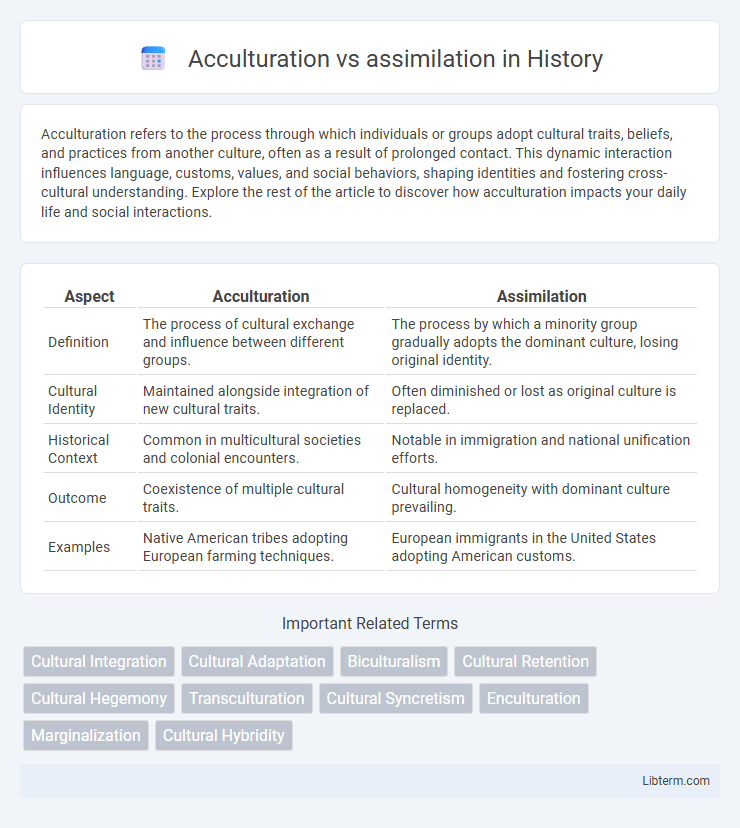Acculturation refers to the process through which individuals or groups adopt cultural traits, beliefs, and practices from another culture, often as a result of prolonged contact. This dynamic interaction influences language, customs, values, and social behaviors, shaping identities and fostering cross-cultural understanding. Explore the rest of the article to discover how acculturation impacts your daily life and social interactions.
Table of Comparison
| Aspect | Acculturation | Assimilation |
|---|---|---|
| Definition | The process of cultural exchange and influence between different groups. | The process by which a minority group gradually adopts the dominant culture, losing original identity. |
| Cultural Identity | Maintained alongside integration of new cultural traits. | Often diminished or lost as original culture is replaced. |
| Historical Context | Common in multicultural societies and colonial encounters. | Notable in immigration and national unification efforts. |
| Outcome | Coexistence of multiple cultural traits. | Cultural homogeneity with dominant culture prevailing. |
| Examples | Native American tribes adopting European farming techniques. | European immigrants in the United States adopting American customs. |
Introduction to Acculturation and Assimilation
Acculturation involves the process where individuals or groups adopt cultural traits or social patterns of another group while maintaining their original identity. Assimilation occurs when an individual or group fully integrates into the dominant culture, often resulting in the loss of original cultural characteristics. Understanding these concepts highlights distinct pathways of cultural adaptation within multicultural societies.
Defining Acculturation: A Multifaceted Process
Acculturation is a multifaceted process involving the exchange and adaptation of cultural traits between groups, resulting in changes to language, customs, and social behaviors. Unlike assimilation, which seeks to fully absorb one culture into another, acculturation allows for the coexistence of original cultural identities alongside new cultural influences. Key factors in acculturation include the degree of contact, power dynamics, and individual or group choices about integration or separation.
Understanding Assimilation: Characteristics and Scope
Assimilation involves the process by which individuals or groups adopt the cultural norms, values, and behaviors of a dominant society, often leading to the loss of their original cultural identity. Key characteristics include cultural absorption, social integration, and the diminishing visibility of distinct ethnic or cultural traits. The scope of assimilation extends to language acquisition, participation in socioeconomic activities, and alignment with societal expectations, significantly impacting personal and group identities within multicultural settings.
Key Differences Between Acculturation and Assimilation
Acculturation involves the exchange and adaptation of cultural traits between groups while maintaining distinct identities, whereas assimilation requires one group to fully adopt the dominant culture, often losing original cultural markers. Key differences include the degree of cultural retention, with acculturation allowing biculturalism and assimilation promoting cultural uniformity. Furthermore, acculturation is typically a two-way process, contrasting with the one-sided nature of assimilation.
Stages of Acculturation Explained
Acculturation involves a dynamic process where individuals or groups gradually adopt cultural traits or social patterns of another group, typically occurring in stages such as initial contact, cultural exchange, adaptation, and integration. These stages reflect increasing levels of interaction and acceptance, from acknowledgment of cultural differences to blending and harmonizing cultural identities. Unlike assimilation, which implies complete absorption into the dominant culture, acculturation allows for the preservation of original cultural elements while fostering mutual influence and coexistence.
The Assimilation Spectrum: From Marginalization to Integration
The assimilation spectrum ranges from marginalization, where individuals reject both their native culture and the dominant culture, to integration, where they embrace the dominant culture while maintaining aspects of their original identity. Acculturation involves adapting to a new culture while retaining cultural heritage, contrasting with assimilation's focus on blending into the host society. Understanding this spectrum highlights the diverse experiences of immigrants negotiating cultural identity within social frameworks.
Factors Influencing Acculturation and Assimilation
Cultural distance, social support networks, and individual personality traits significantly influence acculturation and assimilation processes. Host society attitudes, including levels of openness and discrimination, shape the degree to which immigrants adapt or integrate. Economic opportunities and language proficiency also play critical roles in determining how smoothly individuals acculturate or assimilate into a new cultural environment.
Cultural Identity and Psychological Impact
Acculturation involves adapting to a new culture while maintaining aspects of the original cultural identity, fostering bicultural competence and psychological well-being. In contrast, assimilation often requires relinquishing original cultural traits, which can lead to identity confusion, loss of heritage, and increased stress or mental health challenges. The balance between preserving cultural identity and integrating into a dominant culture significantly influences individuals' psychological adjustment and overall sense of self.
Real-World Examples: Case Studies Across Societies
Acculturation and assimilation manifest distinctly in various societies, as seen in the experience of Mexican immigrants in the United States, where acculturation allows retention of cultural identity while adopting American customs, contrasting with the assimilation observed in indigenous Sami communities in Scandinavia, who faced pressures to adopt mainstream Nordic norms. In Canada, multicultural policies facilitate acculturation by promoting cultural diversity, whereas in France, the emphasis on a unified national identity often pushes for assimilation, as seen in the integration challenges of North African immigrants. These case studies highlight how government policies and societal attitudes shape the balance between maintaining cultural heritage and conforming to dominant cultural norms.
Acculturation vs. Assimilation: Implications for Multicultural Societies
Acculturation refers to the process where individuals or groups adopt cultural traits from another culture while retaining their original identity, whereas assimilation involves fully merging into the dominant culture, often losing distinct cultural characteristics. In multicultural societies, acculturation promotes cultural diversity and coexistence, supporting social inclusion and identity preservation. Assimilation may lead to cultural homogenization, potentially causing identity loss and social tension among minority groups.
Acculturation Infographic

 libterm.com
libterm.com